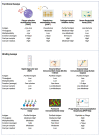Serology as a Tool to Assess Infectious Disease Landscapes and Guide Public Health Policy
- PMID: 35889978
- PMCID: PMC9323579
- DOI: 10.3390/pathogens11070732
Serology as a Tool to Assess Infectious Disease Landscapes and Guide Public Health Policy
Abstract
Understanding the local burden and epidemiology of infectious diseases is crucial to guide public health policy and prioritize interventions. Typically, infectious disease surveillance relies on capturing clinical cases within a healthcare system, classifying cases by etiology and enumerating cases over a period of time. Disease burden is often then extrapolated to the general population. Serology (i.e., examining serum for the presence of pathogen-specific antibodies) has long been used to inform about individuals past exposure and immunity to specific pathogens. However, it has been underutilized as a tool to evaluate the infectious disease burden landscape at the population level and guide public health decisions. In this review, we outline how serology provides a powerful tool to complement case-based surveillance for determining disease burden and epidemiology of infectious diseases, highlighting its benefits and limitations. We describe the current serology-based technologies and illustrate their use with examples from both the pre- and post- COVID-19-pandemic context. In particular, we review the challenges to and opportunities in implementing serological surveillance in low- and middle-income countries (LMICs), which bear the brunt of the global infectious disease burden. Finally, we discuss the relevance of serology data for public health decision-making and describe scenarios in which this data could be used, either independently or in conjunction with case-based surveillance. We conclude that public health systems would greatly benefit from the inclusion of serology to supplement and strengthen existing case-based infectious disease surveillance strategies.
Keywords: LMIC; antibodies; disease etiology; infectious disease surveillance; serology.
Conflict of interest statement
The authors declare no conflict of interest.
Figures


References
-
- WHO . Global Strategy on Comprehensive Vaccine-Preventable Disease Surveillance. World Health Organization; Geneva, Switzerland: 2020.
-
- Jamison D.T., World Bank. Disease Control Priorities Project . Disease Control Priorities in Developing Countries. 2nd ed. Volume xlii. Oxford University Press; Washington, DC, USA: 2006. p. 1401.
-
- Gilbert R., Cliff S.J. Public Health Intelligence. Volume 2016. Springer International Publishing; Cham, Switzerland: 2016. Public health surveillance; pp. 91–110.
Publication types
LinkOut - more resources
Full Text Sources
Miscellaneous

